SU-100Y Self-Propelled Gun
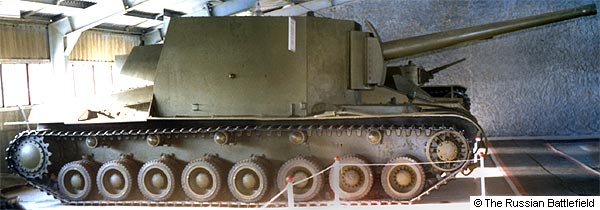 SU-100Y SP-Gun in Kubinka. (V.Potapov)
SU-100Y SP-Gun in Kubinka. (V.Potapov)
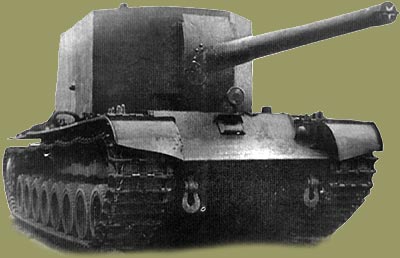
SU-100Y in Kubinka. Autumn 1940 (AKSM)
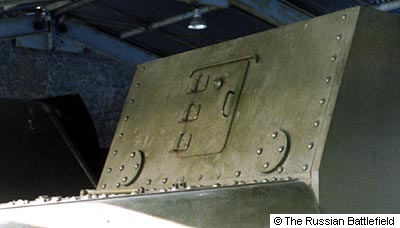
The rear hatch in the fighting compartments of the SU-100Y. Kubinka. (V.Potapov)
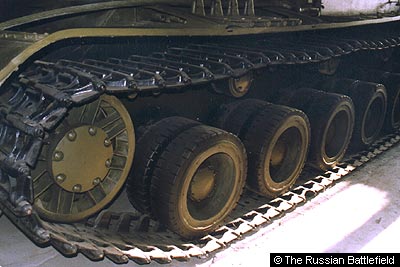
Running Gear. Kubinka (V.Potapov)
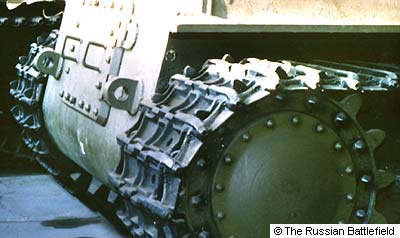
The rear of the SU-100Y. Kubinka (V.Potapov) |
Heavy breakthrough tank T-100 became a base model used for development of several vehicles designed on the basis of experience gained during the war with Finland (1939-1940).
At the beginning of the Soviet-Finnish war the Red Army realized necessity of having dedicated engineering armoured vehicles. Consequently, in the middle of December 1939, War Council of the North-Western Front obliged the Factory #185 to develop and manufacture an armoured engineering vehicle based on the T-100 Heavy Tank. The vehicle was to be used for laying bridges, transport of sappers and explosives, as well as evacuation of damaged tanks from battlefield. As design works were in progress the Head of ABTU Red Army, D. Pavlov, set the task that (cite) "152mm or similar high velocity cannon be fitted on the T-100 tank base" to destroy DOTs (concrete pillboxes) and other fortified structures. Accordingly the director of Factory #185, N. Barykov, requested the War Council of the North-Western Front to change the order to prepare an engineering AFV for the one to re-fit the tank with 100mm or 130mm naval gun. The request was accepted and by 8th of January 1940 drawings of the hull of T-100-X, as the new SP-Gun was designated, were forwarded to Izhorskyi Factory.
The difference between T-100 and T-100-X was that the T-100 had a rotating turret whilst the latter - a wedge-shaped fighting compartment with 130mm B-13 Naval Gun. The vehicle had torsion bar suspension that was prepared by Kirov Factory since it had already gained substantial experience in similar suspensions. During detailing works on the fighting compartment its shape was simplified to reduce manufacturing time. The revised design was designated SU-100Y (in the Soviet designation the "X, Y, Z" letters were latin - iks, igrek, zet), though in few documents it was called T-100-Y. The hull of SU-100Y was shipped form the Izhorskyi Factory on 24th February 1940, and on 1st of March assembling works started. The self-propelled gun was first driven on 14th of March. By that time the Soviet-Finnish War ended and SU-100Y could not be tested under the combat conditions.
Earlier, while the war was still going on, attempts were made to modernise T-100 tank by installing heavier armament. In January 1940 a deputy of National Commisar of Defence and 1st rank army commander G. Kulik, ordered (cite) "to increase the T-100 firepower by installation of 152mm M-10 howitzer to be capable of destroying concrete structures dragon teeth in defence lines". A new turret with 152mm M-10 howitzer was completed in the middle of March 1940 to replace the original turret with 76mm L-11 gun. The new model was designated T-100-Z. Installation of the new turret was abandoned as KV-1 and KV-2 tanks were being brought into service. ABTU suspended all works on further modifications of T-100 tank.
In April 1940 construction bureau of Factory #185 led by Mr. Shufrin produced a design of heavy tank for seashore defence based on T-100 "Object 103". 130mm B-13 naval gun was fitted in the rotating turret and three 7.62mm DT machine-guns were installed. The design however stayed on the drawing board.
As the works on the T-100 were terminated, fate of SU-100Y was sealed. The SP-Gun was transferred to Kubinka in summer 1940. It was not evacuated at the beginning of war. In November 1941, during the most critical stage of the battle of Moscow SU-100Y, together with 152mm gun armed experimental SU-14 and SU-14-1 self-propelled guns, was pressed into service in an Independent Artillery Divizion for Special Duties (there is no mistake, Soviet "divizion" term is similar to battalion but applied for artillery units). Records of the combat employment of the SU-100Y have not been found.
Unlike its base model (T-100), SU-100Y has been preserved and currently is displayed in the Military Historic Museum of Tank Armament and Technology in Kubinka.
В связи с прекращением работ по танку Т-100, дальнейшая судьба СУ-100Y была предрешена. Самоходная установка была передана в Кубинку летом 1940 года. С началом войны САУ никуда не эвакуировалась. В ноябре 1941 года, в наиболее критический момент битвы под Москвой, СУ-100Y, вместе со 152-мм опытными САУ СУ-14 и СУ-14-1, вошла в состав самоходного артиллерийского дивизиона особого назначения. Однако сведений о боевом применении СУ-100Y обнаружить не удалось.
СУ-100Y сохранилась до настоящего времени и находится в Военно-историческом музее бронетанкового вооружения и техники в подмосковной Кубинке.
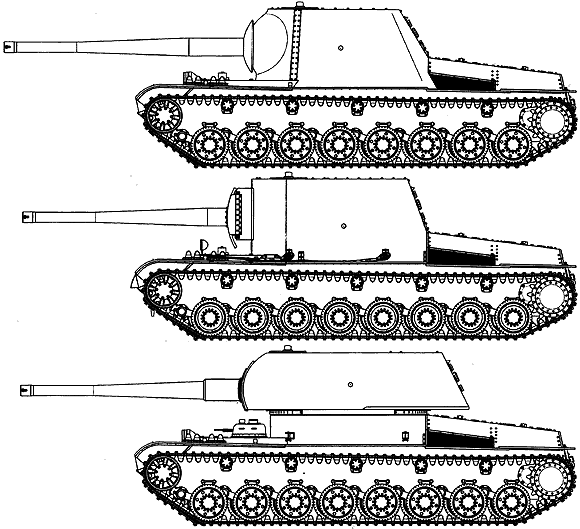 Armoured vehicles based on T-100 chassis: (V.Malginov)
Armoured vehicles based on T-100 chassis: (V.Malginov)
1. T-100-X (first design)
2. T-100-Y (a.k.a. SU-100Y)
3. "Object 103" |
Translated by:
Krzysztof Pawlowski
Sources:
M.Kolomiets, I.Moshanskiy "Mnogobashenniye Tanki RKKA" Fr. Illustratsiya #5, 2000
I.Pavlov, M.Pavlov "Sovetskie Tanki i SAU 1939-1945", Moscow, 1996. |
|










